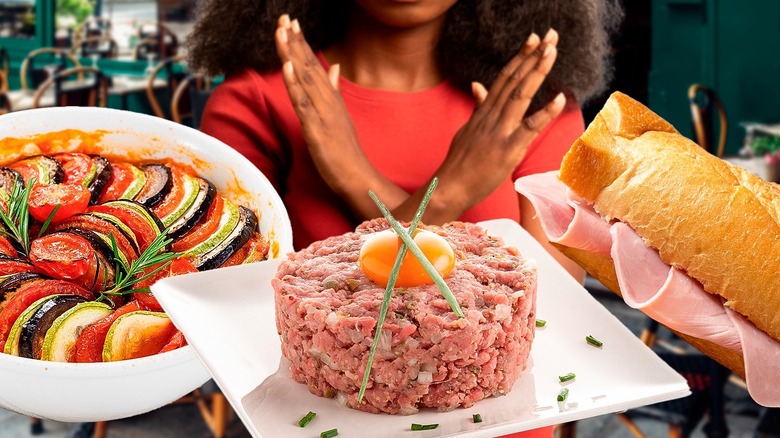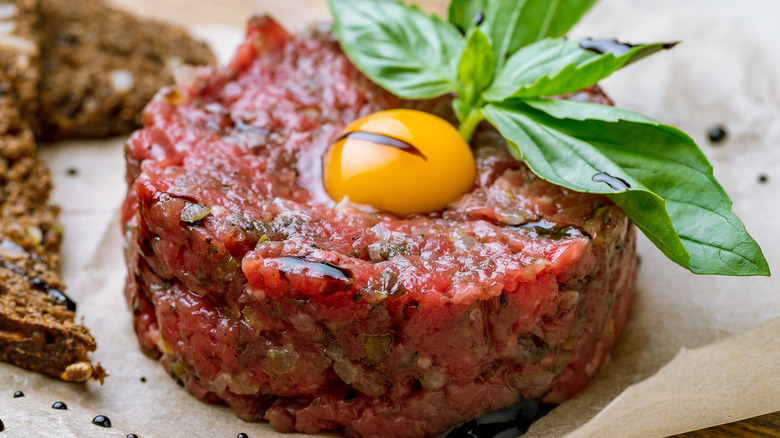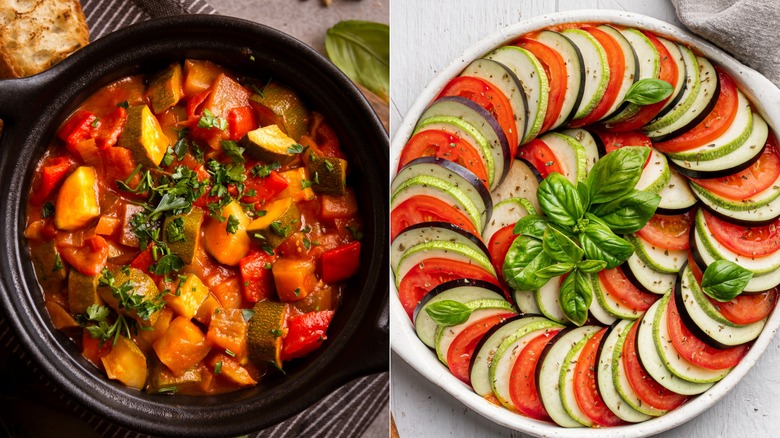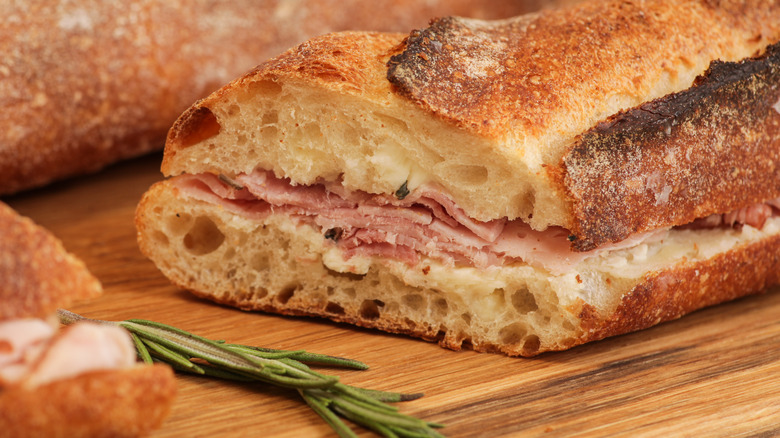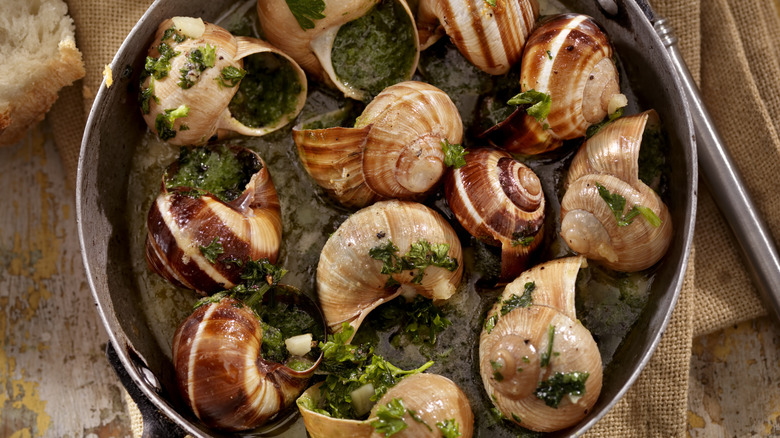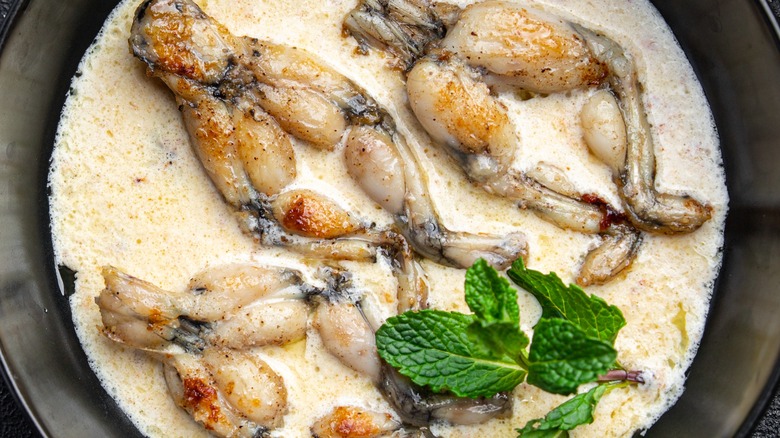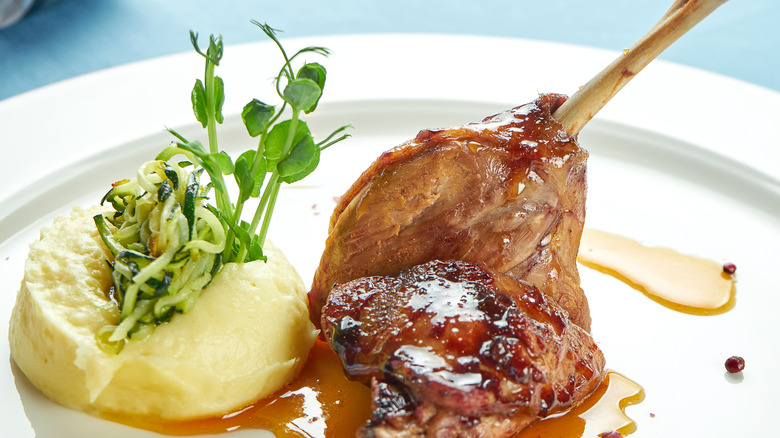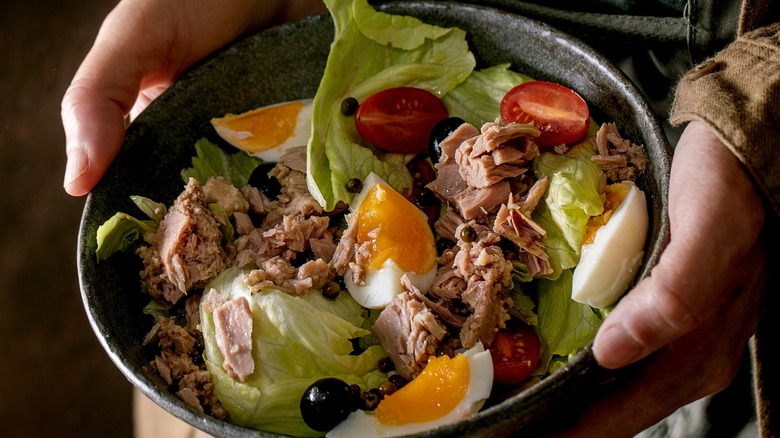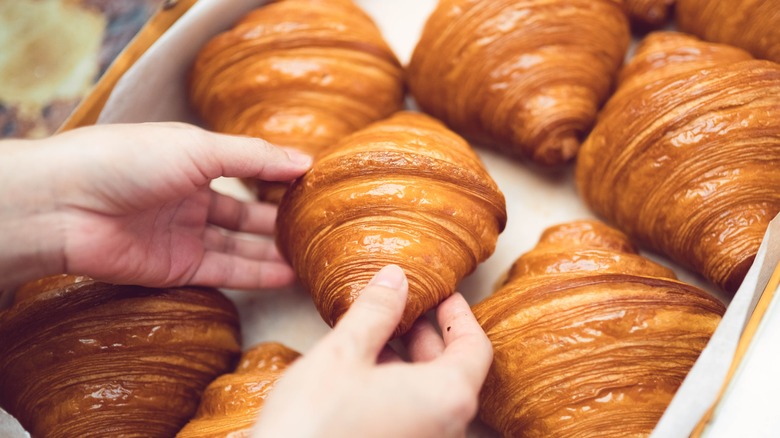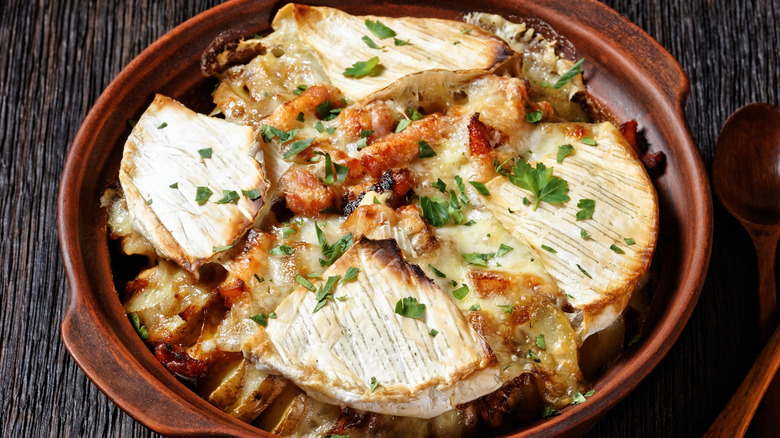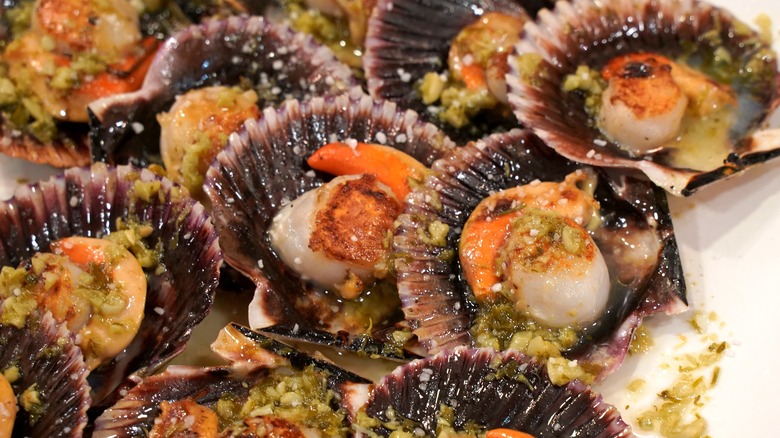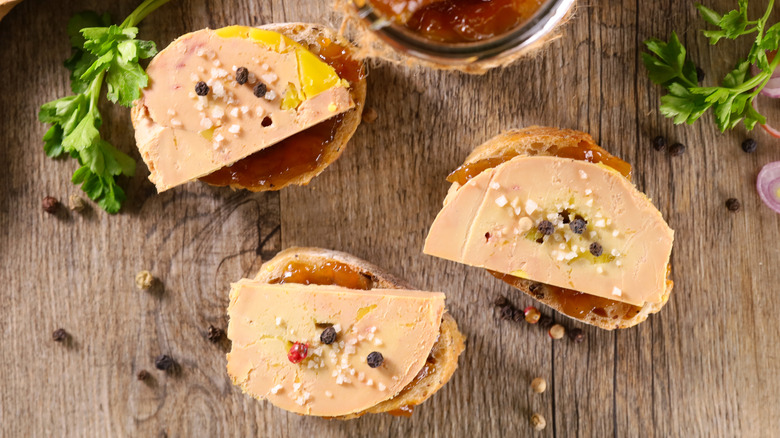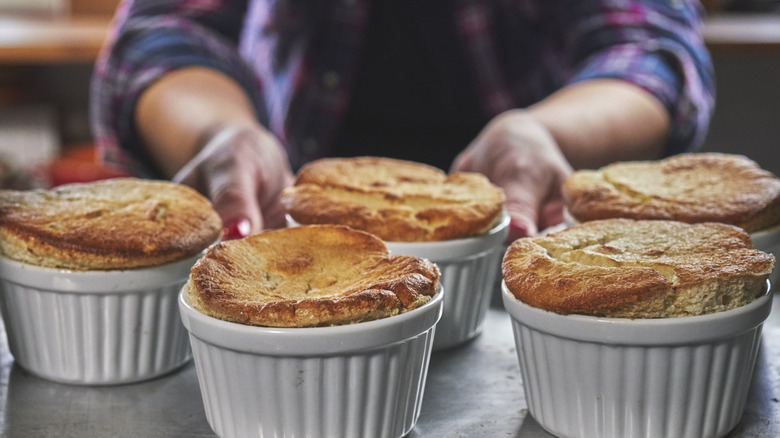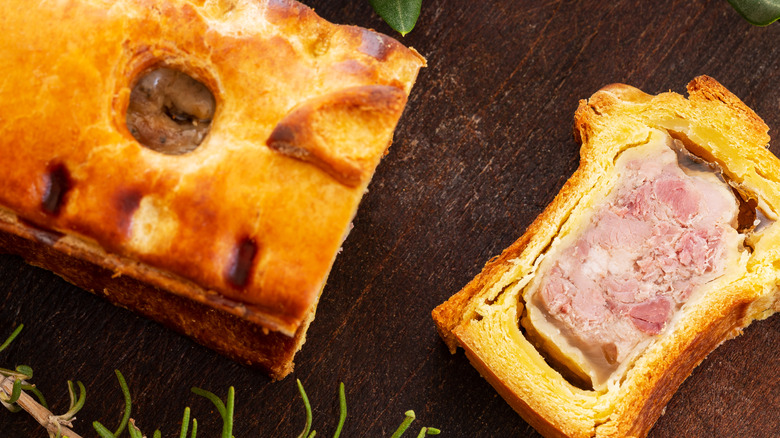13 Dishes To Consider Avoiding At A French Bistro
Simple but satisfying meals are a French bistro's raison d'etre. Traditionally, a French bistro should be comfortably predictable: a down-to-earth, friendly atmosphere that serves food even the pickiest eater can enjoy. We're talking hearty cassoulet (casserole) layered with sautéed vegetables and duck confit, rich, warming stews heaped with melted cheese — the list goes on. To lavish one's food with attention and praise, to savor it is indisputably French, and once upon a time, French bistros served as a place where the lower and middle class could do just that. But in the decades that followed, many bistros have transformed into upscale establishments that serve tiny portions at high prices.
Not every bistro has forgotten its humble origins, however. You'll know you've entered an authentic French bistro when you're greeted by big bowls of soup, fatty cuts of meat, and the scent of melted cheese. But, the menu items are not all created equal. From raw beef to frog legs and duck liver, some traditional French foods no longer fall under the bistro ethos of "simple but satisfying." If you want to savor your traditional French fare as authentically as possible, there are some selections you may want to think twice about ordering from a French bistro.
1. Steak tartare
Everything in steak tartare is raw, from the finely chopped or minced steak to the yolk served atop the tartare like a glistening yellow eye. A varied combination of mustard, Worcestershire sauce, and tabasco hold the meat mixture together, along with savory ingredients like capers, pickles, and parsley. What you end up with is a meal fit for a classy carnivore; there's a reason steak tartare was once a snack of warriors. However, if you have a love for raw beef, you may want to rethink ordering it at a French bistro.
The United States Department of Agriculture does not recommend eating raw meat like steak tartare. Rather, it advises cooking all raw beef, pork, lamb, veal steaks, chops, and roasts until they reach an internal temperature of at least 145 F.
With such strict standards, ordering raw beef and eggs at a restaurant is risky. But if need to satisfy your cravings, you may want to order steak tartare at a highly reputable restaurant or steakhouse instead of a bistro.
2. Ratatouille
As beloved as the famous ratatouille dish may be, it's possible that its 2007 namesake animated film made the meal look a little more substantial than it really is. The peasant dish was traditionally made to satisfy hungry bellies with nutritious vegetables, but times have changed, and so have our appetites. Most people will probably crave some protein to go alongside what is essentially a vegetable medley. That's why many modern versions of ratatouille are served with healthy, lean meat options like grilled chicken or fish. And if you order ratatouille from a bistro hoping to get the visually appealing spiral-patterned meal from the film, you may be in for a rude awakening.
Traditional versions of the vegetable dish aren't prepared in a spiral pattern. In fact, the appetizing, colorful spiral pattern was suggested by a culinary consultant to the film, Thomas Keller. In the movie, the dish is made in the refined confit byaldi style, which gives the vibrant dish its signature spiral. In many establishments, however, there's a good chance that ratatouille will be served in the historically accurate manner of a bowl with mixed vegetables sautéed with garlic, onions, basil, thyme, and other pungent seasonings. The flavors are delicious, but the dish may not satisfy people with robust appetites.
3. Jambon-beurre
Composed solely of bread, butter, and cured ham, the classic French sandwich jambon-beurre (ham-butter) is easy to screw up. One errant ingredient and the whole sandwich can go from oui to non in une minute. First of all, super fresh ingredients are a must, which can be quite the effort for anyone hoping for a quick lunch. The best jambon-beurre is made with a freshly baked artisanal baguette and slathered with a generous amount of butter. And since we're dealing with high-quality ingredients here, it's best for the butter to be salted and have a high-fat content. You don't just use any ham in this sandwich, but jambon de Paris, a wet-cured ham with a distinctly smoky, briny flavor.
If jambon-beurre was any ordinary ham sandwich, we wouldn't be so strict with the rules. But once you bite into the toasted baguette and taste smoky ham mingled with salty butter, you'll never want to go back to ham and Swiss on wheat. Still, not every bistro is going to prioritize using premium ingredients, so unless it's in the heart of Paris or truly dedicated to creating authentic French cuisine, there's a good chance you'll get a cheap imitation of the real thing.
4. Escargot
Escargot: the French dish that makes Americans scratch their heads in wonderment. The idea of popping a slimy, oozy snail into one's mouth isn't very appealing, and we're sure French diners would agree. That's what makes escargot so special and so woefully misunderstood. When you order the traditional dish at a real French bistro, you likely won't be chowing down on a garden-variety snail, and it probably won't be slimy. When done right, escargot tastes like an explosion of butter and garlic with a touch of earthiness. When it's truly authentic, the escargot has taken a long, highly selective journey to your plate. That's what makes them so rare — and so expensive.
The best escargot — the kind used in the most high-class restaurants in France — is imported from the vineyards of Burgundy at the beginning of the winter months. So unless you're in France during the period the prized snails are harvested, you probably won't be eating Burgundy snails at your local French bistro. If you want authentic French cooking that's worth the lofty price, you may want to order something else. And if you're still hankering to try authentic escargot, make a trip to France at the right time.
5. Frog legs
To many of us, eating frog legs may sound unconventional, but its humble beginnings as a dish that French monks fell back on during their annual prohibition of meat consumption in the 12th century threw it into the lights of stardom. A far cry from the old days, frog legs have gained delicacy status and are no longer just a backup plan. This means that the dish commonly shows up on high-class bistro menus and is extremely well-received.
However, frog legs may soon be off the menu. According to a study by Pro Wildlife, the European Union imports 81 to 200 million frogs — roughly 4,070 tons of frog legs — every year, putting its population at risk. The problem has become so dire that Turkey's Anatolian frog, an edible species, is in steep population decline and is considered vulnerable, according to IUCN's Red List of Threatened Species. Our advice? Skip the frog legs. Rumor has it that they taste just like chicken anyway.
6. Duck confit
With its tender texture and complex flavors, duck confit is a classic French favorite. After all, it's not only a satisfying dish but a versatile one that can be served alone or as an ingredient in another bistro staple, the French cassoulet. But it's the characteristics that make duck confit delicious that also make it a risky bistro choice. "Confit" translates to "candied" or "to preserve," which makes sense since duck confit is basically cured duck slathered in fat and cooked for hours. By nature, duck confit is best enjoyed by the foodie who is willing to wait, not by the average person who simply wants to find out what duck tastes like.
Hours of the slow cooking process used for duck confit doesn't make it the best fit for an authentic bistro, which prioritizes quick, easy, and filling meals for people on the go. Plus, duck confit has cemented its status as a gourmet dish, so the average bistro may not even offer it, let alone do it justice. You'd be better off trying a modernized version of the classic French dish, like duck confit tacos.
7. Salade niçoise
Nowadays, a proper dinner feels incomplete without a green leaf somewhere on the plate. A salad is usually a welcome addition at dinnertime, with refreshing green lettuce and plump cherry tomatoes to whet your appetite. This is what makes the traditional salade niçoise so unique ... and complicated. With its anchovies, capers, olives, and beans, this savory dish isn't for everyone, and it's not for every occasion.
Bistros are usually smaller establishments that provide the perfect setting for intimate events like anniversaries and dates; this is a good enough reason to avoid chewing on pungent anchovies and capers for an entire evening. On top of it, you can never really know if the ingredients used to bring your salade niçoise to life are fresh or canned. Something else to consider: Where many authentic bistro dishes are warm and heavy, this one is cold and relatively light. This can be a good thing, but it won't necessarily give you the traditional French bistro experience you've been desiring. If you need to bring your toothbrush to dinner for a dish that may not even use fresh ingredients, is it really worth it?
8. Croissants
When freshly baked, a flaky croissant dripping in butter is the epitome of wholesome French baking — emphasis on baking, not cooking. You see, a bistro soars when it comes to protein-heavy dishes like bouillabaisse (seafood stew) and cassoulet. Bistro dishes are typically layered meals that pack a savory punch. These hearty stews and casseroles are meant to fill you up for hours; a croissant, meanwhile, is the complete opposite.
The cloud-like pastry only calms our hunger for the short duration between breakfast and lunch. Sure, it's pleasantly light and pillowy, and it has layers on the inside. But those layers are usually wispy flakes of bread, not nutrient-filled veggies and fatty poultry. Our point? As talented as bistro chefs undoubtedly are, most of them don't specialize in baking. For the iconic French pastry you've dreamed of, head to the nearest pâtisserie or boulangerie. When you want a croissant done right, you should get it from a bakery, not order it from a French restaurant. By nature, croissants go against everything a bistro is supposed to stand for, so it shouldn't come as a surprise that croissants are more at home in other establishments.
9. Tartiflette
This classic bistro dish is heavy, hearty, and chock-full of carbs and fat. After all, a tartiflette is composed of potatoes, cream, onions, bacon, and cheese. Judging by this description, you may think that a traditional tartiflette is absolutely perfect for a French bistro, which historically serves wholesome comfort food. And if you're making this judgment off of the ingredients alone, you'd be right: Not unlike potatoes au gratin, tartiflette is a rich potato dish topped with big gooey wedges of Reblochon, a French cheese made from raw cow's milk. But the average bistro-goer these days lives in a much different world than the bistro-goer of Paris in the '80s.
A peasant in need of a heavy, stomach-filling meal probably didn't consult their nutritionist before digging into the creamy, cheesy goodness that is tartiflette. In today's world, however, many people might see the ingredients that go into making tartiflette and pause with their forks halfway to their mouths. After all, on a French bistro menu, bacon appears as lardon, which isn't an encouraging sign for anyone in search of a light, fat-free dish. Cream and cheese are all delicious, but not for those who are lactose intolerant.
10. Coquilles Saint Jacques
The word "luxury" only recently started to pop up alongside the word "bistro." But there's no doubt that Coquilles Saint Jacques, a French scallop that's like a salty gift from the sea, tastes like the epitome of extravagance. It even looks opulent, with the browned, seasoned meat nestled in its polished shell. Not only does it look and taste expensive, but it is expensive. Coquilles Saint Jacques is the first shellfish to be certified as authentic by the French government — the respect for Coquilles Saint Jacques is high, and the demand is even higher. Of course, with high demand comes high expectations, which could be crushed upon receiving your plate of less-than-fresh Coquilles Saint Jacques.
You may feel a sense of trepidation whenever you order seafood from a non-seafood restaurant like a bistro. French cuisine is filled with mouthwatering seafood dishes, but a bistro may not be the ideal place to order them. There's no guarantee you'll get the freshest scallops, especially if you're in a landlocked location and the restaurant has to import seafood from far away. If you want the authentic, luxurious Coquilles Saint Jacques experience, you may want to wait until you're sure the scallops are as fresh as can be.
11. Foie Gras
Foie gras translates to "fatty liver" in English, which is a fairly straightforward description of what it is: the liver of a fattened duck or goose. Though it can be a main dish, foie gras' gourmet status means it's expensive to produce, so a little goes a long way ... if it's accessible. Foie gras has been the subject of protests all over the world due to the controversial way birds are force-fed in order to develop fatty livers. This process, called gavage, leaves the birds vulnerable to infections and liver damage. The outcry against foie gras has led to the luxury food item being banned in several countries, including India and Australia.
The protests have gained so much steam in recent years that in 2019, foie gras was banned for sale in New York City by 2022, but legal battles have blocked the ban from going into effect. With all this controversy surrounding what is essentially an expensive appetizer, steering clear of foie gras may be in your best interest. Besides, while foie gras's deliciousness isn't in doubt, it's really just the opening act. It's a fun yet complex flavor that gets you excited for the main event.
12. Soufflé
A soufflé perfectly embodies French culture: It's light and airy on the outside and richly textured and complexly flavored on the inside. But as a French chef (or any chef in general) could tell you, the best soufflé takes time, patience, and training to make. A soufflé is the height of refinement in that it's deceptively difficult to nail. One wrong move and the dish's characteristic cloud-like poof could deflate, leaving you frustrated and without a dessert. The real reason soufflé is so difficult to make comes down to the eggs. You can't just whisk away to your heart's content. In an interview with NPR, chef Jeffrey Buben recommends whisking the eggs for exactly four minutes with 180 beats per minute.
When one type of food requires the highest level of precision, you want to be sure you're getting what you paid for. You'd probably have better chances at an authentic French bakery instead of a bistro. And if a bistro's essence is simple, hearty fare, then a soufflé couldn't be further from that goal for both the customer and the chef. If you were to tell a chef that making a soufflé is simple, they'd probably kick you out of the kitchen.
13. Pâté en croûte
With its pale pink interior riddled with flecks of green and mystery ingredients, this dish doesn't reveal all its secrets at first glance. It's basically every picky eater's worst nightmare. What is it, exactly? Although "pâté" directly translates to "dough," this dish is not made with yeast and flour. It's more of a paste or filling composed of game meats like goose, duck, and pheasant — sometimes other meats are added to the grinder, like lamb and wild boar. The fact that this particular type of pâté is prepared en croûte means it's baked into a crust, like a thick, savory meat pie. It may not look very appetizing, but pâté en croûte is the height of gourmet cooking in France.
Due to this dish's highly specific ingredients, gourmet status, and polarizing reputation, the average cook may not be able to do it justice. For a truly delectable slab of pâté en croûte, you'd be better off spending a few more euros at a fine dining restaurant. That's not to say that a bisto can't serve an expertly-made gourmet dish, but when it comes to pâté, you want to be 100% positive that what you're getting matches the price.
